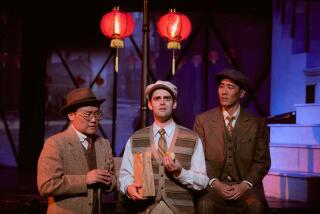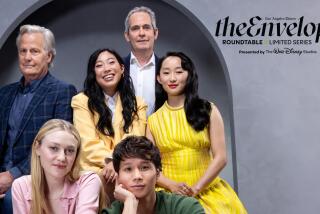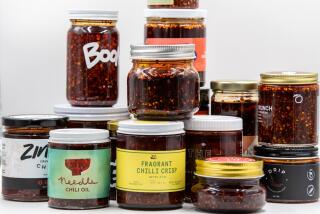What Becomes a Legend Most?
- Share via
For years it seemed that Asian women were doomed to be portrayed in American popular culture as dragon ladies, whores or as ever-suffering, submissive Madame Butterflies. But now, lo and behold, multiculturalism has spread out of the academy and brought us a new breed of startlingly smart, fiery, independent Asian women.
Already this year has seen a groundbreaking James Bond movie in “Tomorrow Never Dies,” which features Hong Kong Kung Fu star Michelle Yeoh as a Chinese spy who is working toward the same end as 007 and is every bit his match. She is brave, savvy and unflappable, not to say a spectacularly skilled athlete who is, perhaps most significantly of all, not easily seduced. And now we have Disney’s new movie, “Mulan” (opening Friday), a marvel of progress vis-a-vis issues of representation such as should make many people cheer, even as it raises the ever-thorny question of authenticity.
Ethnic political correctness was clearly on the minds of the producers in the making of the movie, which is based on a well-known ancient Chinese legend about a woman who, to keep her aging father from being drafted, disguises herself as a man and goes to war in his place. For example, Ruben Aquino, an animator of half-Filipino, half-Japanese descent, spoke explicitly of wanting to make the lead Chinese male, Shang, a “good Asian role model,” and actor B.D. Wong, who supplied the voice of Shang, has praised Disney’s decision to cast Asian American talent for the main roles.
It is true that the invading Hun troops, led by arch-bad guy Shan-Yu, are portrayed as wholly inhuman; if there are any Hun American campus groups, we are sure to hear from them. But in general the movie has a refreshingly enlightened air on the ethnic front, and is sensitive to other issues of our time as well. As a parent, I could not help but applaud the fact that the violence in the movie is held to a minimum, and that “Mulan” is one of the few Disney movies featuring a young woman that is primarily a coming-of-age story rather than a romance. (Though she does earn Shang’s love in the end, the emphasis through most of the movie is on becoming a person who could “look in a mirror and see someone worthwhile.”)
Moreover, the extended scenes of Mulan learning what it means to be a man, compounded with ironic songs about what constitutes “a girl worth fighting for,” naturally raise the topic of gender roles in a helpful way. And, as co-director Tony Bancroft notes, this is a story not only about how Mulan changes, but “how she changes society and their way of seeing her.”
All of this made me delighted to have my 6-year-old see “Mulan”--which he judged to be “awesome”--and I suspect millions of American parents will feel the same way. But what are we to make of the fact that an ancient story of filial piety has been remade into a free spirit’s quest for acceptance and self-esteem? Does authenticity matter? And who has license to elaborate on a legend? It is worth noting that when, some 20-odd years ago, Maxine Hong Kingston made free with the Mulan legend in her classic memoir, “The Woman Warrior,” she precipitated a storm of controversy that has yet to abate. Is “Mulan” likely to do the same? May we expect pickets?
The earliest written version of the Mulan story is in a relatively short Northern Wei (386-534 A.D.) or Tang Dynasty (618-907) ballad that opens with a girl at her weaving loom. In this poem, her concerns are altogether with her father; the stanzas devoted to her 10 years at war focus largely, movingly, on how far she is from home:
At sunset she camped by the Yellow River
She couldn’t hear her parents calling her,
She heard only the Yellow River’s flow surge and splash.
. . . Evening she was atop the Black Mountains;
She couldn’t hear her parents calling her,
She heard only the Tartar Horse on Swallow Mountain
whinny and blow.
Correspondingly, the scene of greatest emotional weight is the one in which Mulan is welcomed home. Yet even in this old ballad, the ostensible message is mixed with another one, the message Kingston and now Disney make much more of than filial piety. For the poem does not end with the straightforward vignette of preparation for a feast, but with the image of two rabbits, which, though male and female, cannot be told apart. Mulan’s successful crossing of the gender boundary is finally what fascinated even the earliest chronicler of the tale.
There have been myriad popular retellings of the Mulan story in China since the Tang dynasty. Many of these contain elaborations and subplots in no way related to the original ballad. In the preface to a 1941 play version staged in Shanghai, playwright Zhou Yibai notes that there is much disagreement even over what dynasty Mulan lived in, and what town, and what her last name was. There are versions of the story in which Mulan kills herself. His own version--influenced, no doubt, by the times--focuses mostly on her military exploits. There are subplots involving a storekeeper’s daughter and a spy; it ends with Mulan being sent back to battle. In contrast, a 1961 Hong Kong children’s book written by Cal Xinyong gives much more weight to her home life. A cousin is also featured in this version, which ends with Mulan marrying her aide.
Given all this, we may well ask why Maxine Hong Kingston was pilloried for making the legend speak to her particular artistic concerns in “The Woman Warrior.” Certainly the legend as she retold it was not a version known in China. Still, the key to the controversy, I think, lies in the context in which she was writing. If she had written her book in China for the Chinese, the question of authenticity would never have arisen.
There would have been no more issue in her fooling with the legend than there was, say, in Chris Van Allsberg presenting Santa Claus as distinctly non-jocular in the popular children’s book “The Polar Express.” Were Van Allsberg to publish his book in China, however, were that book read by large numbers of the Chinese, were there no other representations of Santa available, and were Americans to feel themselves a small and threatened minority, there might well have been an outcry to the effect that his Santa was not Santa.
You have a responsibility, given our situation, to represent Santa accurately, the Amer-Chinese might cry. And if Van Allsberg were to claim he were an artist, with no particular responsibilities regardless of his context, they might well bitterly conclude, Ah, then, you are not one of us. It goes without saying that the more marginal the minority group feels, the more besieged and dimly perceived, the more critical it will feel “authentic” representation to be, and the more mortally betrayed by the specter of “one of its own” choosing her artistic over her ethnic self.
I wonder if “The Woman Warrior” would provoke the kind of emotion today that it did in 1975. Though racism persists, Asian Americans are to be found in many more walks of life than we were then, and there are so many sources of Asian images today besides Kingston’s. The phenomenal burden of being the sole representative no longer rests on her. But what will happen now to “Mulan,” which will undoubtedly fill an enormous, impressionable audience with an image of its heroine that is positive and politically correct by today’s standards but is also as much Disney as it is Chinese? Will there be an outcry? How much have times changed?
That the story has clearly been unabashedly Disneyfied is beyond dispute. Aiding Mulan, to begin with, is a jive-talking dragon named Mushu, whose voice is supplied by Eddie Murphy.
We see traces of earlier Chinese versions of the story in the homesickness of Mulan’s darkest hour; also we see a pentimento of Kingston’s story in the writing of characters on Mulan’s skin. But even these details have taken on a new, telling cast.
Whereas in the ballad, Mulan listens in vain for her parents’ voices, in the movie she laments, “I should never have left home.” The emphasis falls on her actions and her regrets. And whereas in Kingston’s story, characters are carved by her parents on her back--a chilling detail taken, according to some scholars, from the legend of Gen. Yueh Fei--here, the characters are merely notes to herself, written in ink, about how to behave like a lady. Again, her parents, much as she loves them, do not figure so large as she herself does. “Maybe I didn’t go to war for my father,” she sings at one point. “Maybe I went to prove I could do things right.”
Mulan is, in the movie, a great American type: the individual who stands against conventional society. It is no surprise that she is deemed unsuitable for marriage; the men in the army around her are predictably dismissive when (s)he wonders how they would feel about a girl “with a brain, who always speaks her mind.” As one of the tasks set out for Mulan by Disney is the accepting of herself as just such a girl, her gender is revealed in the movie during the course of the war, rather than afterward, as in most versions of the legend.
Thomas Schumacher, a Disney executive, explains that “only when she is acting as herself--not made up as a bride-to-be, not in armor pretending to be a man--does she truly succeed in becoming a hero and save the Emperor’s life. . . . There is a very clear underlying message about honesty and truth and how your greatest empowerment comes from being your true self.” This sounds more like pop Emerson than Confucius, needless to say; the Chinese would be appalled.
Mulan also is openly emotional in a way that reflects the popular ideal of an American woman, but that would appall the Chinese; she is not at all like her woman warrior counterparts in contemporary Chinese films. When Michelle Yeoh plays the heroine in a Hong Kong movie like “Wing Chun,” for example, she is above all self-possessed. The loser of the battles is always someone who loses his or her cool; the ideal woman manifests complete mastery over her emotions. Not that she does not have emotions. Like an American heroine, she tends to fall in love over the course of a movie, and to have that love requited. But she does not show all that she feels, including her suffering; a recurrent theme in the Hong Kong movies is of internal bleeding, of wounds that cannot be seen.
What would a Chinese moviegoer think of Mulan, who gives the emperor a hug and kiss at the end of the Disney movie? At best, I think, he or she would be amused. He or she would not want children to be demonstrative like Mulan, or outspoken either, much less doggedly true to “the real me inside.”
But what about, say, an Asian American? Which heroine do we relate to--the Hong Kong or the Disney? My hunch is that we Asian Americans, especially of the second generation on down, would mostly choose Disney’s Mulan, indeed will root wholeheartedly for her, even as we understand the movie to be most authentically Disney.
What does that say about us? We are not the minority we once were, that’s the truth. I predict that where Disney has gotten so much right--especially its timing--much else will be forgiven. This time around there will be not picket lines, but ticket lines.
More to Read
Only good movies
Get the Indie Focus newsletter, Mark Olsen's weekly guide to the world of cinema.
You may occasionally receive promotional content from the Los Angeles Times.










